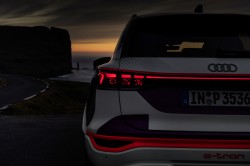Audi Q6 e-tron wants to revolutionize car communications
The upcoming and no longer secret Audi Q6 e-tron isn't just turning heads - it's illuminating the way for a new era in automotive design and safety. How? Through a revolutionary feature: active digital light signatures. And, no, this isn’t the script for a new sci-fi blockbuster; it's happening right here, right now, on our roads.
Here's the scoop. For the first time ever, you, as the car owner, can choose a personalized digital light signature for your headlights and rear lights. No, you won't be shooting lasers or launching fireworks (we know, a pity), but this feature adds a unique, animated design to your car's lighting system. And this isn’t just for show - it serves a practical purpose, too. The lights are intended to communicate with other road users, boosting safety by displaying relevant information via exterior lights. Talk about a bright idea.

With the introduction of second-generation digital OLED rear lights, the Audi Q6 e-tron raises the bar in light design, functionality, and safety. Let's cut the jargon: OLEDs (Organic Light Emitting Diodes) are advanced lights that provide a uniform and highly contrasted light, which can be molded into different shapes and broken down into controllable segments. In other words, your car will be a canvas, and you'll be the digital Picasso, designing your car's lighting aesthetics with a click of a button.
The active digital light signature isn’t just an impressive aesthetic feature, it's also a huge stride towards personalization. Audi has granted drivers the power to customize their car's look with up to eight digital light signatures for the Q6 e-tron. The ability to do so is integrated into Audi's myAudi app and the car's MMI (Multi Media Interface). Your car, your rules, right?

But the innovation doesn’t stop there. Not only do the lights create an impressive visual display, but they also exhibit the car's "brain activity". So, how does this work? In the second-generation OLED rear lights, six 360-segment OLED panels generate a new image every ten milliseconds, creating an animated visual that's constantly in motion. In the front, 12 dimmable segments are used to create the active digital light signature. It's sort of like the exterior of your car having a life of its own, acting as a digital billboard that communicates in real-time.
Now, let's shift gears to safety. These high-tech lights aren't just for vanity. They're practical. With integrated proximity indication and communication lights, the car can warn other road users of potential hazards. It's like having a protective digital halo around your vehicle, communicating vital safety information to others on the road. Moreover, when your car is in automated parking mode, a specific light signature will indicate its status, reassuring nearby road users that it's safe to approach.
That’s all fine and dandy - as long as other road users actually pay attention to the pattern displayed by the lights on your car. While that may work great for other vehicles using ADAS and being in autonomous mode, thus recognizing the signals, people won’t really bother scratching their heads and trying to figure out in a split second what the tiny icons might actually mean. It feels almost as if Audi is focusing a lot of effort on a feature that can be seen by some as a gimmick. Is it because the company is trying to make us look away from its struggles with the PPE platform and looming delays? Or its tie-up with SAIC to (in essence) bypass the VW Group’s issues and speed up development?
Whichever reason it is, the future of automotive lighting is here, and it's dynamic, vibrant, and smart. With Audi's active digital light signature, the car communication is about to get a whole lot brighter. Whether we are ready for it or not - but that’s a completely different thing.








Facebook
Twitter
Instagram
RSS
Settings
Log in I forgot my password Sign up